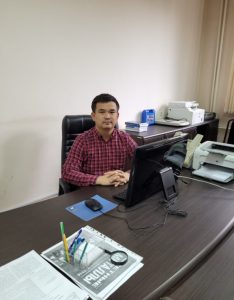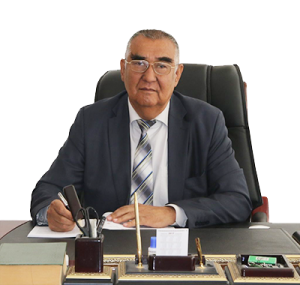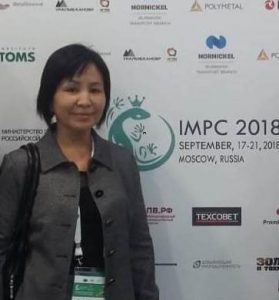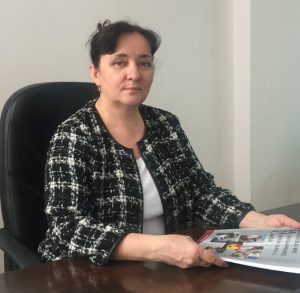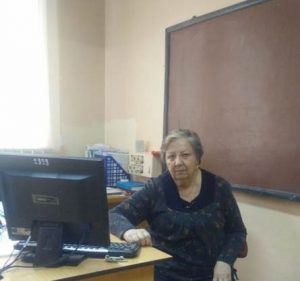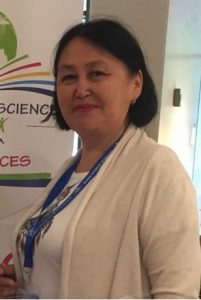АР09259372
«Development of integrated technology to recycle man-made waste from concentrating enterprises using composite reagents and modernized equipment»
Project Manager: Semushkina L.V.
Relevance: For many years of operation of the mining complex, billions of tons of waste from mining and ore beneficiation have been accumulated in dumps and tailings. The maintenance of these facilities requires significant capital and material costs, and the stored crushed beneficiation waste pollutes the soil and atmosphere due to water and wind erosion. The issue of increasing environmental safety can be solved both through the creation of technologies for processing stored beneficiation waste and through the maximum extraction of all useful components. In this regard, the use of modern approaches, new flotation reagents, and modernized equipment for the beneficiation of mineral and man-made raw materials is a priority in the creation of innovative technologies.
Project goal: Development of recycling of enrichment production waste technology using a dispersed emulsion of composite reagents produced in a self-engineered flowing emulsifier. The recycling technology will allow intensification the flotation of raw materials containing gold and non-ferrous metals, increasing the indicators of flotation, the depression of waste rock, modernizing plants equipment.
Expected results. The research will result in:
- development of comprehensive technology for recycling gold-bearing tailings using a composite reagent and self-engineered equipment for its emulsification, which allows increasing the recovery of gold into rough concentrate by 3-5 %;
- development of integrated technology for recycling copper-bearing tailings using a composite reagent and self-engineered equipment for its emulsification, which makes it possible to increase the extraction of copper into rough concentrate by 3-5 %;
- large-scale laboratory tests and development of initial data for the technological regulations for the recycling of industrial waste using the composite reagents emulsion and self-engineered equipment for their emulsification. Recommendations for implementation were issued.
Based on the research results, at least 3 (three) articles and (or) reviews will be published in peer-reviewed scientific publication indexed in the Science Citation Index Expanded of the Web of Science database and (or) having a CiteScore percentile in the Scopus database of at least 35 (thirty-five); as well as at least 1 (one) article or review in a peer-reviewed foreign or domestic publication recommended by Committee for Quality Assurance in Education and Science of the Ministry of Education and Science of the Republic of Kazakhstan.
Achieved results: Development of comprehensive technology for recycling gold-bearing tailings using a composite reagent and self-engineered equipment for its emulsification, which allows increasing the recovery of gold into rough concentrate by 3-5 %.
Publications: 1 Semushkina L.V., Tusupbaev N.K., Turysbekov D.K., Narbekova S.M. Prospects for the processing of technogenic gold-bearing raw materials using a microemulsion of a composite flotation reagent // Beneficiation of ores. - 2021. - No.5.- P.40-45. DOI: 10.17580/or.2021.05.07. Scopus: SJR (2020) - 0,335; Q2, percentile (2020) - 48.
2 Semushkina L.V., Narbekova S.M. On the possibility of flotation processing of technogenic gold-containing waste from enrichment plants // Materials of International Practical Internet Conference «Challenges of Science».- 2021.- Issue IV.- Р.40-47. https://doi.org/10.31643/2021.06
Research team members:
ORCID: 0000-0001-8925-5250
https://orcid.org/0000-0001-8925-5250
SCOPUS: 57204797105
https://www.scopus.com/authid/detail.uri?authorId=57204797105
Google Scolar
https://scholar.google.com/citations?user=--8MrPYAAAAJ&hl=ru
Web of science: P-8970-2017
Publons
https://publons.com/researcher/2044341/semushkina-v-larissa/
ORCID: 0000-0002-6110-0772
https://orcid.org/0000-0002-6110-0772
SCOPUS: 55787968800
https://www.scopus.com/authid/detail.uri?authorId=55787968800
Google Scolar
https://scholar.google.com/citations?hl=ru&user=2UWrxu0AAAAJ
Web of science: AAD-3705-2020
Publons
https://publons.com/researcher/3371509/nessipbay-tussupbayev/
ORCID: 0000-0002-7325-754X
https://orcid.org/0000-0002-7325-754X
SCOPUS: 57194232513
https://www.scopus.com/authid/detail.uri?authorId=57194232513
Google Scolar
https://scholar.google.com/citations?user=aobfWcEAAAAJ&hl=ru
Web of science: P-9642-2017
Publons
ORCID: 0000-0002-2130-683X
https://orcid.org/0000-0002-2130-683X
SCOPUS: 24476385300
https://www.scopus.com/authid/detail.uri?authorId=24476385300
Google Scolar
https://scholar.google.com/citations?view_op=list_works&hl=ru&user=-8uuPbcAAAAJ
Web of science: AAD-3724-2020
Publons
ORCID: 0000-0001-5763-9655
https://orcid.org/0000-0001-5763-9655
SCOPUS: 57194869267
https://www.scopus.com/authid/detail.uri?authorId=57194869267
Google Scolar
https://scholar.google.com/citations?user=6lMMKaAAAAAJ&hl=ru
Web of science: AAD-3423-2020
Publons
https://publons.com/researcher/3369582/zhamikhan-kaldybayeva/
ORCID: 0000-0002-0124-8046
https://orcid.org/0000-0002-0124-8046
SCOPUS: 57196276280
https://www.scopus.com/authid/detail.uri?authorId=57196276280
Google Scolar
ORCID: 0000-0002-5304-6702
Google Scolar
https://scholar.google.ru/citations?hl=ru&user=Hmjd3zIAAAAJ
Publons
AP09258788
«Development of the technology to recover niobium from titanium-magnesium production waste»
Project Manager: Ultarakova A.A.
Relevance: Titanium-magnesium production annually generates thousands of tons of solid waste. Waste reserves in sludge collectors only at Ust-Kamenogorsk Titanium-Magnesium Plant JSC amount to 1270 thousand tons. This waste contains up to 1-2% niobium, which is practically comparable to the niobium content in industrial pyrochlore carbonatite ores. The main objective of the project is to recover niobium from waste (sediments in sludge collectors) into a commercial concentrate that has a high price and is in demand on the world market. The development of this technology also makes it possible to utilize and neutralize waste from titanium-magnesium production, having a beneficial effect on environmental protection.
The project goal is to develop a technology for the recovery of niobium from sediments of a sludge collector of titanium-magnesium production into a demanded commercial concentrate. The project goal will be achieved by mechanical activation of waste before its leaching with alkali and acid solutions, selection of an ion exchanger for sorption and desorption of niobium, precipitation of niobium from solution, and production of concentrate.
Expected results:
- The process of leaching of sludge collector sediments of titanium-magnesium production will be investigated;
- The process of sorption and desorption of niobium from acidic solutions will be investigated;
- The rational process parameters for basic operations of the technology will be determined, and the initial data for the Process Regulations will be issued.
Based on the research results, 3 articles will be published in peer-reviewed scientific journals in the scientific direction of the project, indexed in the Science Citation Index Expanded of the Web of Science database and (or) having a CiteScore percentile in the Scopus database of at least 35 (thirty-five), and 1 article will be published in a peer-reviewed foreign or domestic publication recommended by Committee for Quality Assurance in Education and Science of the Ministry of Education and Science of the Republic of Kazakhstan.
Achieved results:
The process of leaching of sludge collector sediments of titanium-magnesium production
has been investigated. The optimal conditions for two-stage acid leaching have been determined. It was found that two-stage hydrochloric acid leaching of the sludge allows removing the main part of impurities, and removing niobium into the solution by 91.5%.
Publications: 1. Ultarakova A. A., Yessengaziyev A. M., Kuldeyev E. I., Kassymzhanov K. K., Uldakhanov O. Kh. “Processing of titanium production sludge with the extraction of titanium dioxide” / Metalurgija 60 (2021) 3-4, 411-414 p. (Web of Science Q3). https://hrcak.srce.hr/index.php?show=clanak&id_clanak_jezik=372288
2. Naimanbayev M.A., Ultarakova A.A., Lokhova N.G., Kassymzhanov K.K. Complex processing of chloride titanium production wastes. / Materials int. conf. Plaksin Readings - 2021 - Vladikavkaz, - 2021 .-- P. 492-495.
Research team members:
ORCID: 0000-0001-9428-8508
https://orcid.org/0000-0001-9428-8508
SCOPUS: 57192211142 https://www.scopus.com/authid/detail.uri?authorId=57192211142
Google Scolar
https://scholar.google.ru/citations?hl=ru&user=gKWH1_sAAAAJ
Web of science: X-1506-2018
Publons
https://publons.com/researcher/1819499/ultarakova-almagul/publications/
РИНЦ
ORCID: 0000-0003-2803-4977
https://orcid.org/0000-0003-2803-4977
SCOPUS: 55970338600
https://www.scopus.com/authid/detail.uri?authorId=55970338600
Google Scolar
https://scholar.google.ru/citations?hl=ru&pli=1&user=ctL-eYTQ57EC
Web of science: O-4682-2015
Publons
https://publons.com/researcher/1681592/madali-naimanbayev/
РИНЦ
ORCID: 0000-0002-3025-7363
https://orcid.org/0000-0002-3025-7363
SCOPUS: 55831196700
https://www.scopus.com/authid/detail.uri?authorId=55831196700
Google Scolar: https://scholar.google.ru/citations?user=5hS6viAAAAAJ&hl=ru
Web of science ID: O-5905-2017
Publons:
https://publons.com/researcher/2055292/zaure-karshyga/
РИНЦ
ORCID: 0000-0001-9436-5462
https://orcid.org/0000-0001-9436-5462
SCOPUS: 55787859900
https://www.scopus.com/authid/detail.uri?authorId=55787859900
Google Scolar
https://scholar.google.ru/citations?user=j-fWF8IAAAAJ&hl=ru
Web of science: D-1560-2019
Publons
https://publons.com/researcher/1786021/lochova-nina/
РИНЦ
ORCID: 0000-0002-4989-4119
https://orcid.org/my-orcid?orcid=0000-0002-4989-4119
SCOPUS: 57195072267
https://www.scopus.com/authid/detail.uri?origin=resultslist&authorId=57195072267&zone=
Google Scolar
https://scholar.google.ru/citations?user=JzxNDJMAAAAJ&hl=ru
Web of science: AAD-1708-2020
Publons
https://publons.com/researcher/3367167/azamat-yessengaziyev/
РИНЦ
https://www.elibrary.ru/author_items.asp?authorid=1081243
ORCID: 0000-0001-8062-8655
https://orcid.org/my-orcid?orcid=0000-0001-8062-8655
SCOPUS: 57216706159
https://www.scopus.com/authid/detail.uri?authorId=57216706159
Google Scolar: https://scholar.google.com/citations?user=4FNHhRkAAAAJ&hl=ru
Web of science ID: ABD-7287-2021
Publons:
ORCID: 0000-0001-5476-6560
Google Scolar
https://scholar.google.com/citations?view_op=list_works&hl=ru&user=mZlvw8gAAAAJ
Web of science: AAD-2757-2020
Publons
AP09259315
«Разработка инновационной технологии селективного выделения вторичных цветных металлов – меди, никеля и цинка при регенерации растворов электрорафинирования меди»
Project Manager: Gladyshev S.V.
Relevance: Problems in the technology intended to process non-ferrous scrap at the electrorefined copper production stage are the accumulation of unwanted impurities of nickel, zinc, etc. in the circulating electrolyte worsening the grade of the cathode copper obtained. Therefore, part of the electrolyte from the commodity baths is periodically taken from the electrolysis cycle and is processed. The company's productivity and its profitability depend on the efficiency of the operation to clean copper electro-refining solutions, therefore it is important to study the development of an innovative technology for electrolyte regeneration.
Project goal: Development of innovative technology for selective separation of secondary non-ferrous metals-copper, Nickel and zinc during regeneration and complete utilization of copper electro-fining solutions, which will increase the productivity and profitability of the existing enterprise for the production of refined cathode copper and get new, popular and highly liquid products of increased value
Expected results. According to the research results:
- the study of the material composition of commercial copper electrolyte allocated for regeneration and zinc-containing middlings of pyrometallurgical processing of non-ferrous scrap;
- optimal conditions for cleaning the electrolyte by neutralizing zinc-containing products and processing the neutralization sludge with selective release of non-ferrous metals were determined;
- semi-industrial tests of the technology for selective separation of secondary non-ferrous metals (Cu, Ni, Zn) during regeneration of copper electro-fining solutions were carried out;
- calculated the material balance of the technology;
- a report of the conducted research and testing has been compiled;
- initial data for the development of Technological regulations and recommendations for implementation were issued.
- will be published 3 (three) articles and (or) reviews in peer-reviewed scientific publications indexed in the Science Citation Index Expanded of the Web of Science database and (or) having a CiteScore percentile in the Scopus database of at least 35 (thirty-five) and 1 (one) article or review in a peer-reviewed foreign or domestic publication recommended by Committee for Quality Assurance in Education and Science of the Ministry of Education and Science of the Republic of Kazakhstan.
Achieved results: The material composition of the commercial copper electrolyte released for regeneration and zinc-containing intermediate product of pyrometallurgical processing of non-ferrous scrap has been studied. The optimal conditions for cleaning the electrolyte by neutralization with a zinc-containing product have been determined.
Publications:
Gladyshev S.V., Abdulvaliyev R.A., Imangalieva L.M., Fardila - M. Zaihidee, Manapova A.I., Kassymova G.K. Processing of industrial products when disposing of copper electro-refining solutions//News of the National Academy of Sciences of the Republic of Kazakhstan, Series of Geology and Technical Sciences. - 2021. – V. 4. -Р 15-20. Scopus: SJR (2020) - 0,323; Процентиль 40. https://doi.org/10.32014/2021.2518-170X.76
Research team members:
ORCID: 0000-0002-4939-7323
SCOPUS: 55915255800
Google Scolar
https://scholar.google.com/citations?user=3lS90FQAAAAJ&hl=ru
Web of science: O-4294-2017
Publons
ORCID: 0000-0001-6747-6984
https://orcid.org/0000-0001-6747-6984
SCOPUS: 56525298100
https://www.scopus.com/authid/detail.uri?authorId=56525298100
Google Scolar
https://scholar.google.com/citations?hl=ru&user=IlR7XRUAAAAJ
Web of science ID: O-6410-2017
Publons:
ORCID: 0000-0003-2410-670X
SCOPUS: 8987143400
Google Scolar
https://scholar.google.com/citations?hl=ru&user=LFJ_J-EAAAAJ
Publons
ORCID: 0000-0001-5763-5734
SCOPUS: 56770094900
Google Scolar
https://scholar.google.com/citations?hl=ru&user=MApljlcAAAAJ&hl=ru&authuser=1
Web of science: O-6417-2017
Publons
ORCID: 0000-0002-0159-9970
SCOPUS: 57193961730
Google Scolar
https://scholar.google.com/citations?hl=ru&user=QgGDEkoAAAAJ
Web of science: O-6391-2017
Publons
ORCID ID: 0000-0001-5427-6035
https://orcid.org/0000-0001-5427-6035
SCOPUS ID: 57202813152
https://www.scopus.com/authid/detail.uri?authorId=57202813152
Google Scolar
https://scholar.google.com/citations?hl=ru&user=8K-9p8IAAAAJ
Publons: https://publons.com/researcher/3371765/kasymzhanova-asya/
AP09259345
«Research, development, and testing of innovative, integrated, and waste-free technology to process kaolinite clays of Kazakhstan and Egypt with preliminary chemical activation»
Project Manager: Abdulvaliyev R.A.
Relevance: The main difficulties in involving kaolinite clays in the processing are associated with a high content of difficult-to-separate quartzite sand that harms the processing technology and makes production unprofitable. Preliminary chemical activation of raw materials will enable us to conduct the break-down of refractory kaolinite raw materials and efficient gravity concentration to obtain high-quality kaolinite and quartzite products.
Project goal: Research of the mechanism of preliminary chemical activation of kaolinite clays before gravitational preparation, development, and testing of a new technology to process kaolinite and quartzite products.
Expected results.
- physical and chemical composition of kaolinite clays;
- mechanism of preliminary chemical activation;
- the technology of gravity concentration and processing of kaolinite clays;
- the concentration of rare metals and rare earth metals.
- large-scale laboratory tests of the technology;
- Material balance;
- initial data for the Technological Regulations and design of the pilot plant, recommendations for the implementation of the technology.
- 3 (three) articles and (or) reviews have been published in peer-reviewed scientific journals indexed in the Science Citation Index Expanded of the Web of Science database and (or) having a CiteScore percentile in the Scopus database of at least 35 (thirty-five) and 1 (one) article or a review in a peer-reviewed foreign or domestic publication recommended by Committee for Quality Assurance in Education and Science of the Ministry of Education and Science of the Republic of Kazakhstan.
Achieved results: The material composition of representative samples of clays from the Alekseevskoye deposit and ARE has been investigated. The optimal activation mode is temperature 150 ⁰С, duration 120 minutes and concentration 120 g / dm3. After activation, the amount of kaolinite fraction increases during gravity concentration. 10 kg of clayey kaolinite fraction have been produced. The novelty is the study of the mechanism of preliminary chemical activation of kaolinite clays in a sodium bicarbonate solution and the determination of conditions that allow efficiently and qualitatively isolating kaolinite and quartzite products for the production of alumina concentrate, high-value kaolin products and pure quartzite for glass production.
Publications:
Kenzhaliyev B. K., Imangalieva L.M., Manapova A.I., Azlan M.N. Kaolinite clays as a source of raw materials for the aluminum industry of the Republic of Kazakhstan // Complex use of mineral raw materials. Kompleksnoe Ispolʹzovanie Mineralʹnogo syrʹâ/Complex Use of Mineral Resources/Mineraldik Shikisattardy Keshendi Paidalanu, 4 (2021), -Р.5–12. https://doi.org/ 10.31643/2021/6445.34
Research team members:
ORCID: 0000-0001-6747-6984
https://orcid.org/0000-0001-6747-6984
SCOPUS: 56525298100
https://www.scopus.com/authid/detail.uri?authorId=56525298100
Google Scolar
https://scholar.google.com/citations?hl=ru&user=IlR7XRUAAAAJ
Web of science ID: O-6410-2017
Publons:
ORCID: 0000-0001-5956-4730
https://orcid.org/0000-0001-5956-4730
SCOPUS: 56698400500
https://www.scopus.com/authid/detail.uri?authorId=56698400500
Google Scolar
https://scholar.google.com/citations?hl=ru&user=3yzdlHEAAAAJ
Web of science ID: O-4816-2017
Publons: https://publons.com/researcher/2056277/gulnar-abdykirova/
ORCID ID:
0000-0002-9083-0205
https://orcid.org/0000-0002-9083-0205
SCOPUS:57194493565
https://www.scopus.com/authid/detail.uri?authorId= 57194493565
Google Scolar
https://scholar.google.com/citations?hl=ru&user=051sLq1FDzwC
Publons:
https://publons.com/researcher/3371676/pozmogov-valeriy/
ORCID ID: 0000-0003-2006-5840
https://orcid.org/0000-0003-2006-5840
SCOPUS: 56707267400
https://www.scopus.com/authid/detail.uri?authorId= 56707267400
Web of science ID: ААХ-3840-2020
Google Scolar
https://scholar.google.com.tr/citations?hl=tr&user=0UFRJrAAAAAJ
ORCID ID: 0000-0002-1990-3678
https://orcid.org/0000-0002-1990-3678
SCOPUS ID: 56698291800
https://www.scopus.com/authid/detail.uri?authorId=56698291800
Google Scolar
https://scholar.google.com/citations?hl=ru&user=Dh-HPuAAAAAJ
Web of science ID: O-2435-2017
Publons:
ORCID: 0000-0002-0159-9970
SCOPUS: 57193961730
Google Scolar
https://scholar.google.com/citations?hl=ru&user=QgGDEkoAAAAJ
Web of science: O-6391-2017
Publons
ORCID ID: 0000-0002-3258-7948
https://orcid.org/0000-0002-3258-7948
SCOPUS ID: 57193962311
https://www.scopus.com/authid/detail.uri?authorId=57193962311
Google Scolar
https://scholar.google.com/citations?hl=ru&user=QCZYeUUAAAAJ
Web of science ID: O-5873-2017
Publons: https://publons.com/researcher/2055319/alfiyam-manapova/
AP09259455
«Development of a technology for processing pyrite cinders with the extraction of valuable components and preliminary chemical activation of the raw material»
Project Manager: Kenzhaliyev B.K.
Relevance: The accumulated pyrite cinders and wastes pose a real threat of water and air pollution, on the other hand, they are a valuable source of ferrous, non-ferrous and noble metals, which has not been used until now due to the lack of economically viable technologies. In this regard, the development of a rational technology for processing pyrite cinders with the extraction of noble, ferrous and non-ferrous metals is urgent.
The purpose of the project. Development of a rational technology for processing pyrite cinders with the extraction of valuable components. The technology provides for preliminary chemical activation of the raw material with subsequent separation of components, obtaining concentrates of non-ferrous, noble metals and iron in the form of cast iron.
The research will result in the following:
- the composition of a representative sample of pyrite cinders will be determined by physicochemical methods. The main technological parameters of the process of preliminary chemical activation with subsequent separation of components, obtaining a concentrate of non-ferrous metals and iron in the form of cast iron have been developed. The optimal conditions for the chemical activation process will be determined by constructing a mathematical model;
- a method will be developed for the extraction of noble metals from the solid phase of the product of preliminary chemical activation into a separate intermediate product with subsequent separation in the form of a concentrate. The options for opening the middling product with chlorine-containing reagents and a complex reagent based on sulfur compounds are considered. The optimal composition of the complex reagent and leaching conditions will be determined;
- large-scale laboratory tests of the technology for processing pyrite cinders with preliminary chemical activation and obtaining concentrates of non-ferrous, precious metals and iron in the form of cast iron will be performed. The material balance will be calculated. Initial data for the development of technological regulations and recommendations for implementation of the technology will be issued.
As a result of research on this project, at least 3 articles will be published in peer-reviewed scientific journals in the scientific direction of the project, indexed in the Science Citation Index Expanded of the Web of Science database and (or) having a CiteScore percentile in the Scopus database of at least 35 (thirty-five); 1 article in a peer-reviewed domestic publication approved by the Committee for Quality Assurance in Education and Science of the Ministry of Education and Science of the Republic of Kazakhstan.
Results achieved: The composition of a representative sample of pyrite cinders was determined by physicochemical methods. The main technological parameters of the process of preliminary chemical activation with subsequent separation of components and obtaining a concentrate of non-ferrous metals and iron in the form of cast iron have been developed. The optimal conditions for the chemical activation process were determined by the method of constructing a mathematical model. As a result of preliminary chemical activation, the content of harmful impurities of phosphorus, sulfur and arsenic, which affect the quality of the obtained concentrate of non-ferrous metals and cast iron, has been reduced.
Publications: Abikak E.B., Kenzhaliev B.K., Gladyshev S.V., Abdulvaliev R.A., Kasimzhanova A.K. Complex processing of pyrite cinders to obtain a concentrate of non-ferrous metals // XIV international conference "Metallurgy of non-ferrous, rare and noble metals" dedicated to the 40th anniversary of the Institute of Chemistry and Chemical Technology of the Siberian Branch of the Russian Academy of Sciences. 09/06/2021. Krasnoyarsk, Russia. - S. 20-21.
Research team members:
ORCID: 0000-0003-1474-8354
SCOPUS: 6603486541
https://scholar.google.com/citations?hl=ru&view_op=list_works&authuser=3&gmla=AJsN-
Web of science: N-9602-2017
ORCID: 0000-0002-4939-7323
SCOPUS: 55915255800
https://scholar.google.com/citations?user=3lS90FQAAAAJ&hl=ru
Web of science: O-4294-2017
ORCID: 0000-0001-8271-125X
SCOPUS: 55788200200
https://scholar.google.com/citations?user=tzlLuioAAAAJ&hl=ru&oi=sra
Web of science: AAD-3711-2020
ORCID: 0000-0003-3076-0652;
SCOPUS: 56770020200;
https://scholar.google.com/citations?hl=ru&user=GQB_zxIAAAAJ
Web of science: W-7638-2018.
ORCID: 0000-0002-3258-7948
SCOPUS: 57193962311
https://scholar.google.com/citations?hl=ru&user=QCZYeUUAAAAJ
Web of science: O-5873-2017
Publons: https://publons.com/researcher/2055319/alfiyam-manapova/
ORCID: 0000-0002-1582-6732
SCOPUS: 57191433558
https://scholar.google.com/citations?user=tHxdCD4AAAAJ&hl=ru
Web of science: AAD-3707-2020
ORCID: 0000-0001-5427-6035
SCOPUS: 57202813152
https://scholar.google.com/citations?hl=ru&user=8K-9p8IAAAAJ
Web of science: AAD-5518-2020
AP09258880
«Development of technology to obtain manganese pellets for the production of ferrosilicomanganese and high-carbon ferromanganese from fine sludges»
Project Manager: Temirova S.S.
Relevance: as part of the project, it is planned to obtain new data on the synthesis of manganese pellets with improved strength characteristics using modern gravity concentration technologies and new fluxing materials.
Project goal: Development of a technology to obtain manganese pellets for the production of ferrosilicon manganese and high-carbon ferromanganese by efficient enrichment of sludge with obtaining a conditioned concentrate and synthesis of hardened roasted pellets on its basis.
Expected results.
As a result of the research, the following work will be carried out:
- studies on the gravity concentration of manganese sludges with the receipt of conditioned concentrates and fired pellets on their basis;
- large-scale laboratory tests to obtain fired complex pellets, a pilot batch of pellets will be developed;
- large-scale laboratory tests on the smelting of roasted manganese pellets to obtain ferrosilicon-manganese and high-carbon ferromanganese, issuing the initial data for drawing up the Process Regulations; preparing a preliminary business plan.
As a result of research on this project, 3 articles will be published in peer-reviewed scientific journals indexed in the Science Citation Index Expanded of the Web of Science database and (or) having a CiteScore percentile in the Scopus database of at least 35, as well as 1 article in a peer-reviewed domestic publication recommended by Committee for Quality Assurance in Education and Science of the Ministry of Education and Science of the Republic of Kazakhstan.
Achieved results: studies on the gravity concentration of manganese sludges with the receipt of conditioned concentrates and fired pellets on their basis.
Публикации: 1. Aisha Tastanova, Abdykirova Gulnar, Temirova Saniya, Biryukova Alla. Processing of low-grade manganese-containing raw materials with receiving pellets // Materials of International Practical Internet Conference “Challenges of Science”. Issue IV. - 2021. -
Р. 35-39.
https://kims-imio.kz/wp-content/uploads/2021/11/full-book-2021.pdf
Research team members:
ORCID ID: 0000-0003-3039-2546
Scopus Author ID: 55915029400
Researcher ID Web of Science: W-6590-2018
https://scholar.google.com/citations?user=PzgHaJYAAAAJ&hl=ru
ORCID: 0000-0001-8216-679X
Scopus Author ID: 55938162800
Web of Science: N-9712-2017
Google Scholar
https://scholar.google.com/citations?user=RadOw4cAAAAJ&hl=ru
Publons https://publons.com/researcher/2059911/erzhan-kuldeyev/
ORCID ID: 0000-0002-8926-6694
Scopus Author ID: 6505453092
Researcher ID Web of Science: O-4834-2017
https://scholar.google.com/citations?user=nZO7wGAAAAAJ&hl=ru
ORCID: 0000-0001-5956-4730
https://orcid.org/0000-0001-5956-4730
SCOPUS: 56698400500
https://www.scopus.com/authid/detail.uri?authorId=56698400500
Google Scolar:
https://scholar.google.com/citations?hl=ru&user=3yzdlHEAAAAJ
Web of science ID: O-4816-2017
Publons: https://publons.com/researcher/2056277/gulnar-abdykirova/
ORCID ID: 0000-0001-6797-7471
https://orcid.org/0000-0001-6797-7471
SCOPUS: 56912389300
https://www.scopus.com/authid/detail.uri?authorId=56912389300
Google Scolar:
https://scholar.google.com/citations?user=9a5wgCAAAAAJ&hl=ru
Web of science ID: N-7344-2017
Publons: https://publons.com/researcher/2062002/alla-biryukova/
ORCID ID: 0000-0001-9311-9497
Scopus Author ID: 56963807200
Researcher ID: O-9549-2017
https://scholar.google.com/citations?hl=ru&user=KvQ_ys0AAAAJ
AP09259594
«Improvement of the technology to produce chrome pellets from fine sludges to produce high-carbon ferrochrome»
Project Manager: Бондаренко И.В.
Relevance: The beneficiation technologies applied at JSC DGOK do not allow achieving high chromium oxide recovery due to the high dispersion of chromium-containing compounds in minerals, chemical bonding of chromium oxide with gangue minerals. This leads to a low extraction of chromium oxide in finished concentrates and high losses of it with sludge, up to 30% of its content in the feedstock. In addition, up to 10% of fired pellets obtained at the enterprise are characterized by insufficient strength and are substandard. There is a need to produce strong chrome pellets using new binders. The project is aimed at solving these problems: improving the processes of enrichment of fine chrome sludge by chemical and gravity methods; technologies for producing chrome pellets using ferrosilicic-calcium binders, as well as utilization of sludge from chrome production.
Purpose: Improvement of the technology for the production of chromium materials by enrichment of fine sludge by chemical and gravity methods to obtain a rich chromium concentrate and synthesis of hardened pellets on its basis. At the same time, along with an increase in the extraction of chromium oxide from the feedstock, new technological solutions will make it possible to reduce the pellet firing temperature by 150-200 ° C and to extract magnesium and silicon oxide oxides in the form of ammoshenite and forsterite.
Expected results: The research will:
- investigated the physicochemical characteristics of the passport samples of sludge from chrome production and determined the conditions for their chemical and gravitational enrichment;
- large-scale laboratory tests were carried out on the production from chrome slimes of a batch of complex pellets, ammoshenite and forsterite refractory powder;
- large-scale laboratory tests were carried out to melt fired complex pellets to obtain high-carbon ferrochrome; the initial data for drawing up the Technological Regulations were issued; a preliminary business plan has been prepared.
Based on the research results, 3 articles will be published in peer-reviewed scientific journals, indexed in the Science Citation Index Expanded of the Web of Science database and (or) having a CiteScore percentile in the Scopus database of at least 35, as well as 1 article in a peer-reviewed domestic edition recommended by the Committee for Provision quality in the field of education and science of the Ministry of Education and Science of the Republic of Kazakhstan.
Achieved results:
Carried out the selection of passport samples of chrome slimes with the determination of their granulometric, chemical, mineralogical composition; researches on chemical enrichment of chromium sludge by high-temperature sulfatization with a mixture of sulfuric acid and ammonium sulfate, ammoshenite release were carried out; researches on gravity concentration of sulphated product were carried out to obtain rich chromium concentrate and forsterite product.
The optimal composition of the charge and the conditions for the pelletizing of the composition, consisting of chromium concentrate, fine fractions of special coke, diatomite and calcium silicate compounds to obtain "raw" pellets, have been determined; 3-4 times higher than the compressive strength of the pellets used at JSC DGOK.
Publications:
1 Кульдеев Е.И., Бондаренко И.В., Темирова С.С. Физико-химические свойства диатомитов и их использование в технологиях получения промышленной продукции. Монография. Алматы. КазНИТУ им. К.И.Сатпаева, 2021. - 196 с.
Research team members:
ORCID ID: 0000-0002-8926-6694
Scopus Author ID: 6505453092
Researcher ID Web of Science: O-4834-2017
https://scholar.google.com/citations?user=nZO7wGAAAAAJ&hl=ru
ORCID: 0000-0001-8216-679X
Scopus Author ID: 55938162800
Web of Science: N-9712-2017
Google Scholar
https://scholar.google.com/citations?user=RadOw4cAAAAJ&hl=ru
Publons
ORCID ID: 0000-0003-2338-3334
Scopus Author ID:9279232900
ORCID ID: 0000-0001-9528-8753
ORCID ID: 0000-0001-9311-9497
Scopus Author ID: 56963807200
Researcher ID: O-9549-2017
https://scholar.google.com/citations?hl=ru&user=KvQ_ys0AAAAJ
AP09260329
«Improvement of methods refining and modification of wear-resistant chromium Cast Iron in terms of use a high proportion of scrap»
Project Manager: Panichkin A.V.
Relevance:
Currently, an increase in the share of the use of scrap metal and other non-traditional raw materials is observed in the iron foundry industry. This is primarily dictated by economic and environmental considerations and is especially important in the case of obtaining products from expensive wear-resistant high-alloy cast irons. Such products include parts of mills and crushers, which, having served their life, can be remelted to obtain similar products. It should be noted that in some cases the loss of metal from wear of such parts does not exceed 10%, especially if the destruction of the grinding body or armor occurs due to the formation of a crack. Considering the colossal volumes of annual use of such equipment in the world, the amount of generated scrap is large and its processing to obtain similar products is relevant. This task is also important for the Republic of Kazakhstan.
It is known that when smelting cast iron, it is recommended to use no more than 30% of scrap by weight of the charge. This is due to the need to reduce the contamination of the resulting castings with various impurities, including non-metallic inclusions and dissolved gases. An increase in porosity and the proportion of non-metallic inclusions leads to a decrease in the resistance of castings to crack propagation caused by both shock loads and stresses arising in the casting during the cooling stage and often leading to the formation of hot cracks. Hot cracks lead to rejection of a large number of castings. This makes it urgent to study the problem of the formation of porosity and the accumulation of non-metallic inclusions and assess their role in cracking of castings obtained using a high proportion of scrap.
The shape and dispersion of carbide crystals in chromium wear-resistant cast irons determine such important properties as wear resistance, crack resistance, strength, and impact toughness. An increase in the proportion of carbides in the cast iron structure to a certain level increases wear resistance, but decreases toughness and fracture toughness. Increasing the dispersion of eutectic carbides and giving them an equiaxed shape increases wear resistance and toughness. Grinding of carbides and changing their shape during crystallization is possible by various actions on the crystallizing metal, by physical action and modification. Despite the fact that many works have been devoted to the issues of modifying the structure of chromium cast irons under the influence of various factors and added modifiers, the regularities of the complex effect on the parameters of carbides released in alloys of eutectic and hypereutectic compositions during crystallization have not been sufficiently described. This sets the task of conducting research aimed at finding new modifiers, clarifying the modes of modification and thermal treatment of wear-resistant chrome cast iron melts.
Purpose:
Development of a scientifically based approach to the selection of refining and modification modes for wear-resistant chromium cast irons obtained using a high proportion of scrap and scrap to ensure minimal contamination of castings with non-metallic particles and increase the mechanical properties of castings.
Expected results:
As a result of the project, a scientifically grounded approach will be developed to select the modes of refining and modification of wear-resistant chromium cast irons obtained using a high proportion of scrap and scrap to ensure minimal contamination of castings with non-metallic particles and increase the mechanical properties of castings, including:
- the nature of non-metallic particles in the structure of melts of wear-resistant chromium cast irons will be studied and effective methods for their removal will be developed;
- the effect of modifying additives and thermal treatment of the melt on the structure and properties of wear-resistant chromium cast irons will be studied;
- effective methods of refining and modification of chromium cast iron melts obtained in industrial conditions will be developed and tested.
Based on the research results, at least 3 (three) articles and (or) reviews will be published in peer-reviewed scientific journals indexed in the Science Citation Index Expanded of the Web of Science database and (or) having a CiteScore percentile in the Scopus database of at least 35 (thirty five) ;
At least 1 (one) article or review will also be published in a peer-reviewed foreign or domestic edition recommended by Committee for Control of Education and Science.
Results achieved:
Proposed fluxes: MgF2+CaF2, CaF2+B2O3 for refining wear-resistant white chromium cast iron from oxide and sulfide inclusions, protecting them from interaction with the atmosphere during induction melting. New data have been obtained on the effect of temperature (1300-1500 °С) during isothermal treatment of chromium cast iron melts with a carbon content of 2.6 to 4.2 wt.% on the distribution of non-metallic inclusions and porosity. The intervals of cooling rates of chromium cast irons, at which there is an enlargement of non-metallic inclusions of manganese sulfide and nitride, have been determined. It is shown that replacing a CaF2 flux with B2O3 and 50 wt% B2O3 + 50 wt% CaF2 flux promotes a deeper cleaning of a chromium wear-resistant cast iron melt from sulfide (by ~ 75%) and oxide (by ~ 70%) nonmetallic inclusions. The effect of melt desulfurization from the use of a flux of 50 wt.% B2O3 + 50 wt.% CaF2 is comparable to alloying the alloy with silicocalcium CK30 in an amount of 1%. However, the use of fluxes containing B2O3 reduces the life of the induction furnace lining. Nitrogen dissolved in the cast iron melt is removed only by vacuum melting.
Publications:
1 Panichkin A.V., Korotenko R.Yu., Kenzhegulov A.K., Kshibekova B.B., Alibekov Zh.Zh. Porosity and non-metallic inclusions in cast irons obtained using a high proportion of scrap // Complex use of mineral raw materials (Forwarded to the editorial office)
2 Uskenbaeva A.M., Panichkin A.V., Mamaeva A.A., Kenzhegulov A.K., Kshibekova B.B. To improve the properties of wear-resistant chromium cast irons // Bulletin of KazNRTU (sent to the editorial office)
Research team members:
ORCID: 0000-0002-2403-8949
https://orcid.org/0000-0002-2403-8949
SCOPUS: 6506771167
https://www.scopus.com/authid/detail.uri?authorId=6506771167
Google Scolar
https://scholar.google.com/citations?user=qJvngQoAAAAJ&hl=ru&oi=ao
Web of scienceAAD-3003-2020
Publons
https://publons.com/researcher/3369172/alexander-panichkin/publications/
ORCID: 0000-0002-9659-8152
https://orcid.org/0000-0002-9659-8152
SCOPUS: 57200535299
https://www.scopus.com/authid/detail.uri?authorId=57200535299
Google Scolar
https://scholar.google.com/citations?user=6adlNWsAAAAJ&hl=ru&oi=ao
Web of science: N-8690-2017
Publons
https://orcid.org/0000-0002-0540-5651
https://orcid.org/0000-0001-9603-910X
Scopus Author ID: 57189294473 (EID: 2-s2.0-84968584165)
Scopus Author ID: 57193837774 (EID: 2-s2.0-85017001773)
Google Scolar:
Web of science ID: AAI-3141-2021
ORCID: 0000-0001-7001-2654
https://orcid.org/0000-0001-7001-2654
SCOPUS: 57210622996
https://www.scopus.com/authid/detail.uri?authorId=57210622996
Google Scolar
https://scholar.google.com/citations?user=umeQ_s4AAAAJ&hl=ru&oi=ao
Publons
ORCID: 0000-0002-5944-7865
https://orcid.org/0000-0002-5944-7865
Google Scolar
https://scholar.google.com/citations?hl=ru&pli=1&user=kjZZ0QoAAAAJ
Web of science: ABE-9527-2021
Publons
AP09258789
«Development of a modified hydrometallurgical technology for extracting copper from off-balance dumps using catalytic biooxidants»
Project Manager: Koizhanova A.K.,
Relevance: This project is aimed at creating a technology capable of solving the environmental problems of copper leaching, as well as increasing the recovery in comparison with the traditional method.
The preliminary production of flotation copper concentrates is also widely used, with the possibility of their further melting or sale. The hydrometallurgical production of cathode copper is currently represented by a small number of enterprises that process oxidized copper raw materials with a low content of interfering iron-bearing minerals, using the standard SX-EW technology. Refractory, off-balance copper raw materials, accumulated in dumps and tailings, in many cases contain significant amounts of ferrous iron compounds, which can seriously complicate the process of extracting copper into a productive solution. Solving this problem by improving the standard liquid-extraction technology will make it possible to involve in industrial processing raw materials of this type, with the receipt of finished products of cathode copper with a purity of at least 99.99%.
Project: Development of an improved method of copper sulfuric acid leaching from difficult and refractory dumps, by neutralizing impurities that increase the consumption of sulfuric acid and slow down the dissolution of oxidized copper minerals. Intensification of the copper dissolution process from already oxidized mineral forms and the elimination of raw materials components that hinder the process of leaching will be carried out by introducing oxidizing reagents and bio-catalysts into the process.
Expected results.As a result of the research:
- optimized leaching regimes will be worked out, with the selection of oxidizing bio-catalysts concentrations;
- efficiency and completeness of copper extraction into a productive solution using oxidizing and catalyzing biological components will be determined;
- enlarged laboratory tests will be carried out in the full hydrometallurgical cycle;
- preliminary economic efficiency of the use of catalytic biooxidants will be assessed;
- semi-industrial tests of the modernized hydrometallurgical technology for producing cathode copper will be carried out at a plant;
- technological regulations will be drawn up and recommendations for industrial implementation will be issued.
Based on the results of the project, at least 3 (three) articles and (or) reviews will be published in peer-reviewed scientific journals, indexed in Science Citation Index Expanded of the Web of Science database and (or) having a Cite Score percentile in the Scopus data base of at least 35 (thirty five) ; as well as at least 1 (one) article in peer-reviewed foreign and (or) domestic editions recommended by Committee for Quality Assurance in Education and Science of the Ministry of Education and Science of the Republic of Kazakhstan.
Achieved results:
A hydrometallurgical technology has been developed for extracting copper from off-balance dumps using catalytic biooxidants. The use of a catalyzing bacterial culture A. Ferrooxidans accelerates oxidative processes and increases the degree of copper extraction by an average of 8-10%.
Publications:
Koizhanova A.K., Magomedov D.R., Tastanov E.A., Kenzhaliyev B.K., Sedelnikova G.V., Berkinbayeva A.N. Intensification of copper leaching from heaps using biological oxidation // Metalurgija. 2021. Scopus: SJR (2020) - 0,269; Q3, процентиль (2020) - 46. (In the press).
Research group:
ORCID: 0000-0001-9358-3193
SCOPUS: 55788200200
Google Scolar: https://scholar.google.com/citations?hl=ru&user=bMsDTwgAAAAJ
Web of science: N-4602-2019
Publons:https://publons.com/researcher/2909814/aigul-k-koizhanova
ORCID: 0000-0003-1474-8354
SCOPUS: 6603486541
Google Scolar
https://scholar.google.com/citations?hl=ru&view_op=list_works&authuser=3&gmla=AJsN-
Web of science: N-9602-2017
Publons
ORCID: 0000-0002-6073-348X
SCOPUS: 57205165757
Google Scolar:
https://scholar.google.com/citations?view_op=list_works&hl=ru&user=jJ5bYR0AAAAJ
Web of science: AAD-3721-2020
ORCID: 0000-0001-7216-2349
https://orcid.org/0000-0001-7216-2349
SCOPUS: 55787675500
https://www.scopus.com/authid/detail.uri?authorId=55787675500
Google Scolar:
https://scholar.google.com/citations?user=LIYK_pwAAAAJ&hl
Web of science ID: AAD-3687-2020
Publons:
ORCID: 0000-0001-8145-5741
https://orcid.org/0000-0001-8145-5741
SCOPUS: 57205164164
https://www.scopus.com/authid/detail.uri?authorId=57205164164
Google Scolar
https://scholar.google.com/citations?user=v9dubFkAAAAJ&hl=ru
Publons
ORCID: 0000-0002-7496-5097
SCOPUS: 55788714400
Google Scolar: https://scholar.google.com/citations?view_op=list_works&hl=ru&user= DECx76gAAAAJ
Web of science: AAD-3716-2020
Publons:https://publons.com/researcher/3371504/maria-erdenova/
ORCID: 0000-0002-2062-9573
AP09258805
«Development of equipment for heating and rheological movement of dispersed technogenic and mineral materials in sublimation electric furnaces for dearsenation of raw materials»
Project Manager: Trebukhov S.A.
Relevance: The existing methods of thermal processing of dispersed raw materials (at atmospheric pressure and in a vacuum), predominantly imply forced material movement using rabbling, directed vibration waves, fluidization by gas flow in the reaction zone of sublimation electric furnaces. Concerning vacuum processes, it is problematic to supply a heat flow for heating dispersed material due to the absence of convective flows of the gas phase and maintaining the lowest possible pressure at a high temperature inside electric furnaces for processing dispersed raw materials. The project proposes the development of the design of sublimation equipment, where the movement of the material flow of dispersed material is performed from top to bottom due to rheological properties, and heat is supplied by direct heating of open sections of the processed bulk material due to radiation from the heater.
Project goal: Development of equipment for heating and rheological movement of bulk material and for supplying heat in sublimation vacuum furnaces as applied to the technology of dearsenation of technogenic and mineral raw materials.
Expected results. As a result of achieving the objective and tasks of the project, a pilot unit will be created and tested on a model material and arsenic-containing raw materials. The created equipment will serve as a prototype for the manufacture of the industrial unit applied to the processing of technogenic and mineral arsenic-containing raw materials.
The project results can be used both on the territory of the Republic of Kazakhstan (for example, dearsenation of gold-bearing refractory concentrates from the Bakyrchik, Sayak-IV deposits, etc.) and has an export orientation (dearsenation of local foci of soil pollution/territories of industrial zones around enterprises producing fuchsin (aniline) and others in Switzerland, Poland, the Russian Federation, and some other countries).
Achieved results: As a result of the study in 2021, the temperature rheological characteristics of dispersed arsenic raw materials were determined and the sintering temperatures of dispersed arsenic raw materials were established using the example of arsenic-containing concentrates from 7 deposits at atmospheric pressure and in vacuum.
For the unification of the developed equipment for the sublimation processing of arsenic containing raw materials in a vacuum, the angle of inclination of the guides or the angle of the generatrix of the cone with respect to the horizontal should be at least 55 degrees. The latter is a fundamental condition for the constructive development of the process of rheological movement of material in the sublimation space.
It was found that the sintering temperatures of arsenic-containing concentrates fluctuate within 800-1000°C, which makes it possible to implement the process of rheological displacement in the technological cycle. For concentrates with a lower sintering temperature, a granulation process can be recommended, which can increase the sintering threshold by 50-100°C.
2 variants of the evaporator design are proposed: the first of them is made in the form of a column formed by conical guide surfaces, the larger base of which is directed upward, the second - downward. The first of them is preferable for equipment with low productivity, the second opens up the possibility of scaling, since several columns made of truncated cones with a large base downward can be installed inside the evaporator, which provides sufficient conditions for removing the vapor phase from a significant volume of dispersed material.
Methods for supplying heat flux and constructive placement of heaters for both proposed versions of evaporators for processing dispersed sulphide materials have been developed. The design of the heaters has been developed and the materials for their manufacture have been proposed. Thermal tests of potential materials for the resistance body of heaters have shown that the current density of 1 A/mm2 for graphite and up to 8-9 A/mm2 for the specified steel provides heating of the resistance body up to 1000-1100°C, with a voltage drop of 10-12 and 10 V/m (respectively).
The performed research and design developments are sufficient for the preliminary design of a sublimation unit with rheological material movement in a vacuum volume.
Publications:
1 Володин В.Н., Требухов С.А., Ниценко А.В., Требухов А.А., Тулеутай Ф.Х. Некоторые проблемы переработки дисперсного мышьяк содержащего сырья сублимацией в вакууме / 28-я Всероссийская научно-техническая конференция с международным участием «Вакуумная техника и технологии – 2021», 22-24 июня 2021 г. Российская Федерация, г. Санкт-Петербург. С.23-26. http://vacuumtt.org/gallery/%D0%92%D0%A 2%D0%A2-2021.pdf (in. Rus.)
2 Volodin V.N., Trebukhov S.A., Nitcenko A.V., Trebukhov A.A., Tuleutay F.Kh. Some Problems of Processing Dispersed Arsenic-Containing Raw Materials by Sublimation in Vacuum / Journal of Physics: Conference Series, 2059 (2021) 012026. (Scopus Q4, Percentile/Materials Science/ - 18). http://dx.doi.org/10.1088/1742-6596/2059/1/012026 (in Eng.)
Research team members:
https://orcid.org/0000-0002-0683-1409












